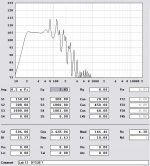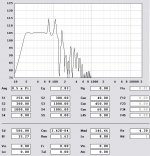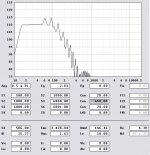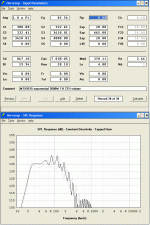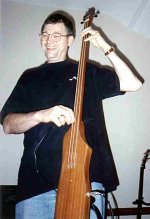Six months on and still no sawdust on my part. Tsk, tsk.Don Bunce said:
Posts start at #110,and are scattered through the next several pages. Freddyi's sim is at post 130,and finalized plan is at post 176.
I'm gonna call my friend in the morning and remind him of his promise of workshop time......
is that a pic of the cone or the surround?iand said:
Don't I know it -- this is what happens to a (very expensive!) McCauley 6174 subwoofer (Hvc=40mm, Hg=10mm) when driven with repeated bass notes at the 25Hz reflex tuning frequency where cone excursion is reduced...
And it occurred when the excursion was very low?
Welcome deerndlph,
William Cowan ran some numbers on the Thunder (see post #699). He suggested 400-2200cm^2, with 5.2M length and front tap back 50cm from mouth.
Your version is over 700 L and his is almost 600 L, so you better have a fork lift if you plan to move them. My horn (290 L) seems small by comparison
MTX didn't publish Le in the spec sheet I got. You're using 4, is it really that high?
William Cowan ran some numbers on the Thunder (see post #699). He suggested 400-2200cm^2, with 5.2M length and front tap back 50cm from mouth.
Your version is over 700 L and his is almost 600 L, so you better have a fork lift if you plan to move them. My horn (290 L) seems small by comparison
MTX didn't publish Le in the spec sheet I got. You're using 4, is it really that high?
thanks for the speedy replys guys
is the sim above for this horn?
http://img236.imageshack.us/img236/5929/tappedhornplans002kn5.jpg
this is very interesting
so with this cabinet and the lab 12 driver, can this achieve 20-60hz and play loud and clear? are u happy with it?
if you could link me to the horn resp graphs for this it would be cool
i am looking to build 1 of these asap
looks like i have most the info i need, but i will have to shorten the length from 90" to 89" but im guessing this will make no noticeable difference (low ceiling..)
im thinking of being simple and just using a plate amplifier like the 1 below? or maybe a more powerfull one?
http://www.bmm-electronics.com/Product.asp?Product_ID=4707
will a subsonic filter at 12hz 24db/octave be suitable for a tapped horn sub?
and will the 16db/octave adjustable crossover if set to about 60hz be suited, here it will cross with my current 12" subs that will be placed nearby (will upgrade the mid bass later)
thanks
nathan
is the sim above for this horn?
Last year I did exactly what you have in mind.I made it 90" long,and used the LAB12 driver.The answer to your questions are yes.
http://img236.imageshack.us/img236/5929/tappedhornplans002kn5.jpg
this is very interesting
so with this cabinet and the lab 12 driver, can this achieve 20-60hz and play loud and clear? are u happy with it?
if you could link me to the horn resp graphs for this it would be cool
i am looking to build 1 of these asap
looks like i have most the info i need, but i will have to shorten the length from 90" to 89" but im guessing this will make no noticeable difference (low ceiling..)
im thinking of being simple and just using a plate amplifier like the 1 below? or maybe a more powerfull one?
http://www.bmm-electronics.com/Product.asp?Product_ID=4707
will a subsonic filter at 12hz 24db/octave be suitable for a tapped horn sub?
and will the 16db/octave adjustable crossover if set to about 60hz be suited, here it will cross with my current 12" subs that will be placed nearby (will upgrade the mid bass later)
thanks
nathan
deerndlph said:Hey,
I am new to this and have found myself bitten by the TH bug. I have two MTX 9515 woofers one being the SVC and the other being a DVC .
I was wondering if anyone has simulated this driver in hornresponse in a TH and if they would post the input parameters. I am attaching my input parameters so I may get some feed back from you guys on what I can do to make this better. Measure twice cut once. I intend on building with the SVC version woofer as it has not been used the other driver has been in another box before. Thanks for the previous post I am learning alot.
dee
Hi Dee
Here's an exponential version with the same total volume but much flatter response and slightly lower excursion -- compression ratio is higher, horn is longer, mouth area is larger.
Cheers
Ian
Attachments
(Don Snyder)
Thanks for the reply I didn't realize that I had put that version up there I was looking at what the differences would be by experimenting with the addition of coils The actual Le according to MTX is .8mH. It did smooth it out but not drastically. Thanks for the info about the other post. I am looking through them now.
I know this is a monster of a box that is why I was looking for some pointers.
dee
Thanks for the reply I didn't realize that I had put that version up there I was looking at what the differences would be by experimenting with the addition of coils The actual Le according to MTX is .8mH. It did smooth it out but not drastically. Thanks for the info about the other post. I am looking through them now.
I know this is a monster of a box that is why I was looking for some pointers.
dee
the simulation for the lab 12 above in Post #1404 looks good, what is the horn size?, i tried to model in horn resp, but it wont let me get the tapped horn option clickable, and it has different parameters options than your design above
and looking at whats in your plot i have no clue how to place that into atual dimensions
dosent matter i made it so i can model a tapped horn, just dont know how to get this into a atual real life design
and looking at whats in your plot i have no clue how to place that into atual dimensions

dosent matter i made it so i can model a tapped horn, just dont know how to get this into a atual real life design
"is that a pic of the cone or the surround?"
No, that's the coil. The copper colored part (top of photo) is the middle of the coil (in the gap), the black (bottom of photo) is the overhung portion.
"And it occurred when the excursion was very low?"
This kind of damage is common for long overhung coils when driven near Fb, or more than an octave and a half higher.
In traditiona horns the minimal excursion points occur just above Fc, and again one octave above.
In a 21hz Fc tapped horn the sim also shows another sharp minima at 48hz. Playing strong dance music (with it's heavy 50hz content) would be a problem. For portable PA use the minima is at 80hz or above (with an Fc of 32hz or higher), and there is also a small peak in the resonse there too, so you won't need to be driving a ton of power there.
No, that's the coil. The copper colored part (top of photo) is the middle of the coil (in the gap), the black (bottom of photo) is the overhung portion.
"And it occurred when the excursion was very low?"
This kind of damage is common for long overhung coils when driven near Fb, or more than an octave and a half higher.
In traditiona horns the minimal excursion points occur just above Fc, and again one octave above.
In a 21hz Fc tapped horn the sim also shows another sharp minima at 48hz. Playing strong dance music (with it's heavy 50hz content) would be a problem. For portable PA use the minima is at 80hz or above (with an Fc of 32hz or higher), and there is also a small peak in the resonse there too, so you won't need to be driving a ton of power there.
Naudio said:
what are the dimensions for this horn, thanks
The volume is 350 Liters. I have not designed an enclosure, this has to be done by the one who builds them. If you know www.danleysoundlabs.com then look at the dts20, it is about the same size and performance.
Have a look at this website, there is valuable information in the download and tapped horn section:
http://www.volvotreter.de/dl-section.htm
djk said:"is that a pic of the cone or the surround?"
No, that's the coil. The copper colored part (top of photo) is the middle of the coil (in the gap), the black (bottom of photo) is the overhung portion.
"And it occurred when the excursion was very low?"
This kind of damage is common for long overhung coils when driven near Fb, or more than an octave and a half higher.
In traditiona horns the minimal excursion points occur just above Fc, and again one octave above.
In a 21hz Fc tapped horn the sim also shows another sharp minima at 48hz. Playing strong dance music (with it's heavy 50hz content) would be a problem. For portable PA use the minima is at 80hz or above (with an Fc of 32hz or higher), and there is also a small peak in the resonse there too, so you won't need to be driving a ton of power there.
I had quite a long discussion with Scott Holden at McCauley about this, and he agreed that this was the likely cause of failure -- not really McCauley's fault, all drivers like this will handle lots of power just so long as the cone is moving because they rely on lots of air pumping over the coil to keep it cool, and this happens under the AES test conditions where a wideband noise signal is used.
When driven with repetitive signals at or near a box tuning frequency (reflex, bandpass, tapped horn) the power handling is greatly reduced, and the problem is made even worse by the fact that the current will be at a maximum because this is an impedance minimum. Under these circumstances real power handling is likely to be between a half and a quarter of the data sheet value.
Of course this is unlikely to happen to most people. However when you have a bass player with a home-made long-scale 3-string bass tuned to G/D/A (25Hz bottom note) playing a dance tune with repetitive low G for 2 minutes into a 16ft3 reflex tuned to 25Hz...
Ian
Hi Ian : I'd like to know more about the 3 stringed bass. Is it yours? I thought the low stuff we heard on the records was doctored. I don't have any instrumentation, but when I played around with GoldWave, it sounded like the Fundamental in the songs I examined was weak, and the overtones were providing most of the energy (the old "missing fundamental" trick).
To Mavo
The inductance Le for the lab 12 driver is 1.48 mH according to the datasheet but you have put 8mH in Hornresp, this changes the model quite a bit, is this just a mishap or is there something I do not understand ?
Cheers
Andreas
The inductance Le for the lab 12 driver is 1.48 mH according to the datasheet but you have put 8mH in Hornresp, this changes the model quite a bit, is this just a mishap or is there something I do not understand ?
Cheers
Andreas
Hi Mavo
Thank you for you answer
Would it work ? putting a ~6 mH coil in series with the woofer, thus creating a low pass filter in the meantime, Sure it would alter the inductance of the total system but the added coil is not exactly placed in the moving system at the voice coil former?
is the effect we see comparable just to eq'ing the system to flat response.
Cheers
Andreas
Thank you for you answer
Would it work ? putting a ~6 mH coil in series with the woofer, thus creating a low pass filter in the meantime, Sure it would alter the inductance of the total system but the added coil is not exactly placed in the moving system at the voice coil former?
is the effect we see comparable just to eq'ing the system to flat response.
Cheers
Andreas
Have a look at the picture in this post:
http://www.diyaudio.com/forums/showthread.php?postid=1425046#post1425046
it is the interior of a DTS20. In the following post, William Cowan explains what we can see on it. Treat Le just as another variable in the process of designing a TH (well, cant make it smaller than what you got with the driver, but you can add more).
http://www.diyaudio.com/forums/showthread.php?postid=1425046#post1425046
it is the interior of a DTS20. In the following post, William Cowan explains what we can see on it. Treat Le just as another variable in the process of designing a TH (well, cant make it smaller than what you got with the driver, but you can add more).
Don Snyder said:Hi Ian : I'd like to know more about the 3 stringed bass. Is it yours? I thought the low stuff we heard on the records was doctored. I don't have any instrumentation, but when I played around with GoldWave, it sounded like the Fundamental in the songs I examined was weak, and the overtones were providing most of the energy (the old "missing fundamental" trick).
Hi Don
It (see photo) belongs to our bass player Tony Penneck -- he often uses a 5-string bass where the bottom string is normally low B, and used to tune it down to low G just for that tune but it always sounded a bit feeble -- so he built "the stick" using a piezo pickup under the bridge, these often have more fundamental than an electric pickup. Being fretless it could also do things like an octave slide down (G50 to G25) which you would normally only think a synth can do.
With some added boost at 25-30Hz using parametric EQ it used to make the hall shake quite nicely -- not loud as such, just a feeling that the room was wobbling.
It did often have problems with picking up buzzes on stage and we don't do that tune any more so it's been retired -- the lowest note we use nowadays is low C (32Hz) which is why I'm targeting this not 25Hz for my next bass bin build.
Cheers
Ian
Attachments
- Home
- Loudspeakers
- Subwoofers
- Collaborative Tapped horn project
